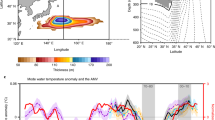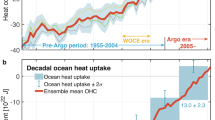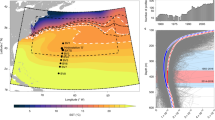Abstract
Over the past six decades, the subtropical surface ocean has warmed at rates close to those of global mean surface ocean temperature1 except in western boundary current regions where the surface warming is locally enhanced by a factor of two2. Changes in the subsurface ocean, however, remain unclear because of lack of data. Compiling historical temperature measurements—some available for the first time—here we show that the subtropical mode water has warmed over the past six decades in both the North Pacific and North Atlantic. The rate of the warming is twice as large in the mode waters than at the surface. Subtropical mode waters are important water masses of vertically uniform temperature that are a few hundred metres thick and distributed widely in the main thermocline of the subtropical oceans3. The enhanced warming of subtropical mode waters can be traced back to the surface warming in the formation regions along the western boundary current extensions. Furthermore, we detect increased temperature stratification and decreased dissolved oxygen in the subtropical mode waters. The latter change has clear implications for predicting biogeochemical responses to climate warming.
This is a preview of subscription content, access via your institution
Access options
Access Nature and 54 other Nature Portfolio journals
Get Nature+, our best-value online-access subscription
$29.99 / 30 days
cancel any time
Subscribe to this journal
Receive 12 print issues and online access
$209.00 per year
only $17.42 per issue
Buy this article
- Purchase on Springer Link
- Instant access to full article PDF
Prices may be subject to local taxes which are calculated during checkout



Similar content being viewed by others
References
Deser, C., Phillips, A. & Alexander, M. Twentieth century tropical sea surface temperature trends revisited. Geophys. Res. Lett. 37, L10701 (2010).
Wu, L. et al. Enhanced warming over the global subtropical western boundary currents. Nat. Clim. Change 2, 161–166 (2012).
Hanawa, K. & Talley, L. D. in Ocean Circulation and Climate (eds Siedler, G., Church, J. & Gould, W. J.) 373–386 (Academic, 2001).
Masuzawa, J. Subtropical mode water. Deep-Sea Res. 16, 463–472 (1969).
Worthington, L. V. The 18° water in the Sargasso Sea. Deep-Sea Res. 5, 297–305 (1959).
Kwon, Y.-O. & Riser, S. C. North Atlantic subtropical mode water: a history of ocean-atmosphere interaction 1961–2000. Geophys. Res. Lett. 31, L19307 (2004).
Xie, S-P., Xu, L., Liu, Q. & Kobashi, F. Dynamical role of mode water ventilation in decadal variability in the central subtropical gyre of the North Pacific. J. Clim. 24, 1212–1225 (2011).
Takahashi, T. et al. Climatological mean and decadal change in surface ocean pCO2 and net sea–air CO2 flux over the global oceans. Deep-Sea Res. 56, 554–577 (2009).
Oka, E. et al. Decadal variability of subtropical mode water subduction and its impact on biogeochemistry. J. Oceanogr. 71, 389–400 (2015).
Mantua, N. J. et al. A Pacific interdecadal climate oscillation with impacts on salmon production. Bull. Am. Meteorol. Soc. 78, 1069–1079 (1997).
Hurrell, J. W. Decadal trends in the North Atlantic Oscillation: regional temperatures and precipitation. Science 269, 676–679 (1995).
Wang, H., Xie, S.-P. & Liu, Q. Comparison of climate response to anthropogenic aerosol versus greenhouse gas forcing: distinct patterns. J. Clim. 29, 5175–5188 (2016).
Frankignoul, C. & Kestenare, E. The surface heat flux feedback. Part I: estimates from observations in the Atlantic and the North Pacific. Clim. Dynam. 19, 633–647 (2002).
Saba, V. S. et al. Enhanced warming of the Northwest Atlantic Ocean under climate change. J. Geophys. Res. 121, 118–132 (2016).
Sun, S., Wu, L. & Qiu, B. Response of the inertial recirculation to intensified stratification in a two-layer quasigeostrophic ocean circulation model. J. Phys. Oceanogr. 43, 1254–1269 (2013).
Xu, L., Xie, S-P., Liu, Q. & Kobashi, F. Response of the North Pacific subtropical countercurrent and its variability to global warming. J. Oceanogr. 68, 127–137 (2012).
Karl, D. et al. The role of nitrogen fixation in biogeochemical cycling in the subtropical North Pacific Ocean. Nature 388, 533–538 (1997).
Cheung, W. W. L. et al. Shrinking of fishes exacerbates impacts of global ocean changes on marine ecosystems. Nat. Clim. Change 3, 254–258 (2013).
Boyer, T. P. et al. World Ocean Database 2013 NOAA Atlas NESDIS 72, 209 (eds Levitus, S. & Mishonov, A.) (Silver Spring, 2013).
Akima, H. A new method of interpolation and smooth curve fitting based on local procedures. J. Assoc. Comput. Mach. 17, 589–602 (1970).
Rayner, N. et al. Globally complete analyses of sea surface temperature, sea ice and night marine air temperature since the late nineteenth century. J. Geophys. Res. 108, 4407 (2003).
Huang, B. et al. Extended reconstructed sea surface temperature version 4 (ERSST.v4). Part I: upgrades and intercomparisons. J. Clim. 28, 911–930 (2015).
Kaplan, A. et al. Analyses of global sea surface temperature 1856–1991. J. Geophys. Res. 103, 18567–18589 (1998).
Rayner, N. et al. Improved analyses of changes and uncertainties in sea surface temperature measured in situ since the mid-nineteenth century: the HadSST2 data set. J. Clim. 19, 446–469 (2006).
Minobe, S. & Maeda, A. A. 1degree SST dataset compiled from IOCADS from 1850 to 2002 and Northern Hemisphere frontal variability. Int. J. Climatol. 25, 881–894 (2005).
Taylor, K. E., Stouffer, R. J. & Meehl, G. A. An overview of CMIP5 and the experiment design. Bull. Am. Meteorol. Soc. 93, 485–498 (2012).
Sugimoto, S. & Kako, S. I. Decadal variation in winter mixed layer depth south of the Kuroshio Extension and its influence on winter mixed layer temperature. J. Clim. 29, 1237–1252 (2016).
Trenberth, K. E. et al. in Climate Change 2007: The Physical Science Basis (eds Solomon, S. et al.) 235–336 (Cambridge Univ. Press, 2007).
Sen, P. K. Estimates of the regression coefficient based on Kendall’s tau. J. Am. Stat. Assoc. 63, 1379–1389 (1968).
Kendall, M. G. A new measure of rank correlation. Biometrika 30, 81–93 (1938).
Acknowledgements
S.S. is supported by a Grant-in-Aid for Young Scientists (B) (Grant 15K17756) from the Japan Society for the Promotion of Science; T.S. by the Japan Fisheries Research and Education Agency; S.-P.X. by the US National Science Foundation (1637450) Natural Science Foundation of China (41490640, 41490641), and Tohoku Forum of Creativity.
Author information
Authors and Affiliations
Contributions
S.S. led this study and performed the analyses. T.S. and K.H. contributed to the development of the idea. T.W. conducted data quality control. S.S. and S.-P.X. wrote the manuscript with feedback from all authors.
Corresponding author
Ethics declarations
Competing interests
The authors declare no competing financial interests.
Supplementary information
Supplementary Information
Supplementary Information (PDF 6154 kb)
Rights and permissions
About this article
Cite this article
Sugimoto, S., Hanawa, K., Watanabe, T. et al. Enhanced warming of the subtropical mode water in the North Pacific and North Atlantic. Nature Clim Change 7, 656–658 (2017). https://doi.org/10.1038/nclimate3371
Received:
Accepted:
Published:
Issue Date:
DOI: https://doi.org/10.1038/nclimate3371
This article is cited by
-
Cold- versus warm-season-forced variability of the Kuroshio and North Pacific subtropical mode water
Scientific Reports (2023)
-
The benefits of high-resolution models in simulating the Kuroshio Extension and its long-term changes
Climate Dynamics (2023)
-
Influence of North Pacific subtropical mode water variability on the surface mixed layer through the heaving of the upper thermocline on decadal timescales
Journal of Oceanography (2023)
-
The downward spiralling nature of the North Atlantic Subtropical Gyre
Nature Communications (2022)
-
Enhanced North Pacific subtropical gyre circulation during the late Holocene
Nature Communications (2021)



